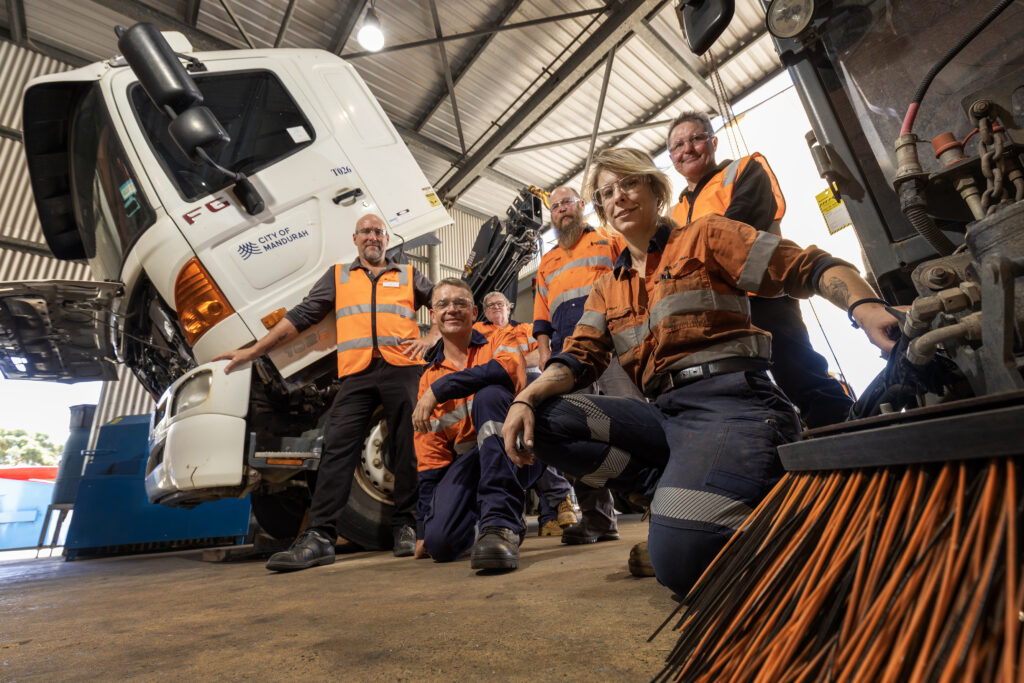Fit for work and worker’s compensation
South West WorkCare Forum | Wednesday 30 August, 2023

Waste trucks, graders, brigade emergency vehicles, ride-on lawn movers, hi-abs and community buses are just a few examples of the diversity of local government fleet. The variety of WA local government fleet and plant reflects the many services that members deliver.
Across the state local governments have over $780 million worth of fleet and plant assets protected by LGIS.
At a glance
South West WorkCare Forum | Wednesday 30 August, 2023
Getting back to work – Injury
management, LGIS Office Ergonomic Champions and more.
Mental health issues are increasingly prevalent throughout organisations; 1 in 5 Australians are
diagnosed with a mental health condition every year (such as depression, anxiety and substance use).
30 June 2023 marks the second year that LGIS has provided Scheme motor fleet protection for members. Although the first two years have been bumpy (as expected), the benefits to members of a mutual approach has shone through.
Feedback from members has been overwhelmingly positive, with many reporting a significant improvement in claims management.
Motor claim trends based on the last five years data show that LGIS received 5107 number of claims between 2018 and 2023, of which member at fault claims contributed to 3179.
Although some of these claims were inescapable there are many which may have been avoided with improved risk management. LGIS aims to help members improve their fleet risk management and claims performance to improve outcomes for their organisation and the Scheme.
From a fleet perspective, proactive risk management is the number one priority for LGIS members to reduce accidents, claims, injury, and get the most out of their fleet and plant. Lifting the standard of fleet management so that it’s consistent across the sector will deliver benefits for all; improving the risk profile of the entire LGIS membership.
Fleet risk management is the process an organisation uses to ensure the safety and security of its drivers, operators, vehicles and heavy/plant machinery. For local government it can be a complicated business given the vast variety of vehicles and plant they own – for example the risk considerations for a grader will be different to a community bus or ride-on-lawn mower.
In 2022 LGIS conducted a pilot motor risk program to benchmark the sector’s fleet safety performance, controls, management practices and ultimately identify areas for improvement across the sector. 17 LGIS members participated in the pilot with key findings highlighting sporadic and inconsistent approaches to fleet risk management across participants.
Members from across the state participated in the pilot with representation from metropolitan cites, and regional towns and shires. The LGIS team reviewed participant’s claims profile and documentation; conducted site visits and interviews. The assessment focused on three areas, and applied it separately for regular fleet and heavy machinery. In total, participants were assessed against 93 criteria, and were scored as yes, partial or no.
Following the assessment, each participating member was provided with a report outlining the findings and key recommendations.
Review of pilot participant’s claims profile highlighted a combination of small cumulative claims, compounded by large one off losses, mostly related to high value items. Consistently across the pilot group, at fault claims accounted for the vast majority of claims and costs.
The table below outlines the pilot group’s contribution in terms of causation and cost.
The claims outturn indicates a lack of accountability and control within the fleet environment. Looking at the trends for motor claims in the commercial insurance market, the performance of WA local governments is outside the standards expected of commercial fleet. As shown earlier the claims profile of the pilot group is mirrored across the member base.
Inflationary and supply chain impacts are also driving up the costs of claims with nearly 50% upward movement in the average cost of claim. In addition to direct costs in relation to the vehicles, injury, downtime and business interruption increase the members overall cost of risk, which is less prominent and likely to go unnoticed.
It is important to consider ergonomic features before you purchase any vehicle, be it passenger vehicles or heavy plant machinery.
Buyers should consider the workers who drive or operate these vehicles and machinery to reduce the potential of musculoskeletal injury.
Prior to new purchases, review the information gathered from staff with the use of the LGIS ergonomic checklists. Using the checklist will help make sure that equipment meets requirements and that any current issues with fleet vehicles are considered and potentially eliminated.
The checklist includes a range of areas including vehicle safety such as reverse cameras to ergonomic issues such as access and hand rail position to seat adjustments/suspension and weight ratings.
Having an open dialogue with your staff and the manufacturer during the purchasing process ensures that you’re bringing in fleet vehicles that suit your workforce.
Manufacturers have been working hard over the last few years to improve features and adjustability within their products with a huge focus on driver comfort. Fleet vehicle improvements include refinement in seat adjustments, blind spot sensors, and rear and side view cameras. All these modifications aim to improve driver experience, and reduce the risk of awkward postures when driving.
Here are some guidelines to consider when determining the ergonomic seat features required for your fleet operations.
It’s also important to consider passengers in your vehicles as the passenger seats are often limited in their design, even though they are exposed to the same environmental factors as the driver or operator.
In single or dual cab trucks, there is often very little leg room for crew members who attend site in one vehicle, particularly when they add water and lunch bags. Considering a larger fleet vehicle with specific storage requirements can be beneficial.

Whether it’s making sure that waste is collected, roads are maintained and that sports fields are bounce down ready, it only happens because of the sector’s specialist equipment and operators’ breadth of fleet and assets.

The City of Mandurah was one of the 17 LGIS members who participated in the motor fleet pilot program. Across the City there’s
a proactive risk approach and this was apparent when assessing
their fleet and plant management.

It was April 2022 when the LGIS injury prevention team visited Craigie Leisure Centre (CLC) to review the Kindy Gym program.
LGIS is the unifying name for the dedicated suite of risk financing and management services for WA local governments, established by the WA Local Government Association in conjunction with JLT Public Sector (part of the Marsh group of companies). LGIS is managed by JLT Public Sector (ABN 69 009 098 864 AFS Licence 226827).
Risk Matters, via this website, is designed to keep members, their staff and elected members informed on topical risk management and insurance issues and LGIS programs and services.